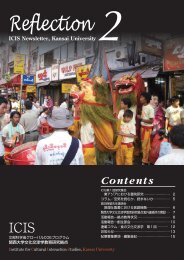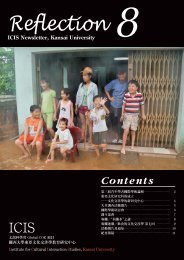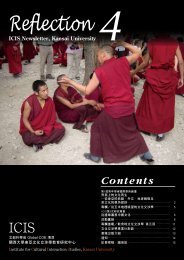English
English
English
Create successful ePaper yourself
Turn your PDF publications into a flip-book with our unique Google optimized e-Paper software.
Phases of the East Asian Countries from the Perspectives of the Culture of Ships<br />
― A comparison of regions centering on Ryukyu Islands in the Early Modern Era ―<br />
On the 16 th and 17 th October, 2010, ICIS hosted the international symposium “Phases of the East Asian Countries<br />
from the Perspectives of the Culture of Ships ― A comparison of regions centering on Ryukyu Islands in the Early<br />
Modern Era ―” at Faculty of Education room 107, Senbaru Campus of Ryukyu University of the Ryukyus.<br />
The symposium focused on the periphery regions of East Asia in<br />
the Early Modern Era for the comparison of actual situation of<br />
cultural interactions. This followed from two preceding international<br />
symposiums: “Culture and History of Hue ― From the perspective of<br />
its relations to the surrounding villages and outer regions” held in<br />
September 2009 and “Topology in East Asian Countries from the<br />
Perspectives of Royal Tombs – The royal tombs of the Joseon<br />
Dynasty and its periphery” held in July 2010 (see page 7).<br />
The symposium aimed at stimulating the discussion from the<br />
perspectives of the “Culture of Ships”, especially focusing on the<br />
island nation, Ryukyu, whose culture always had inevitable<br />
correlations with the culture of ships. The scholars were invited from<br />
a wide area, such as Japan, Korea and Vietnam to share their<br />
respective current research and exchange academic research ideas.<br />
To begin with, MATSUURA Akira (Professor, ICIS)gave a<br />
keynote speech entitled “Exchanges in East Asian Sea Region by<br />
Chinese Sailboats”. He explained about the activities of Chinese ships<br />
in East Asian Sea area based on the statistic data abstracted from<br />
historical materials, also referring to the Middle Age, and showed<br />
pictures and photographs of Chinese ships that greatly influenced on<br />
many regions in East Asia.<br />
In the first session themed<br />
“Culture of Ships in the Island<br />
Nation, Ryukyu”, three papers were<br />
presented; “Ships and the History<br />
of Ryukyu ― Various phases about<br />
the Ryukyu ships in the Early<br />
Modern Era” by TOMIYAMA<br />
Kazuyuki (Professor, University of<br />
the Ryukyus), “History of Sino-<br />
Ryukyu-Japan Exchanges from the<br />
Prof. Tomiyama Kazuyuki Perspectives of the Crew ―<br />
Focusing on the examples of<br />
escort ships and Hisen” by FUKAZAWA Akihito (Part-time Lecturer,<br />
Okinawa International University), and “What is Seen in the Field ―<br />
Extinction, alteration and succession of the early modern ships and<br />
their dynamic movement” by ITAI Hidenobu (Fellowship Researcher,<br />
Okinawa University). The reports showed new approaches and<br />
achievements of the researches related to the national policies and<br />
regionalism in the Early Modern Ryukyu, the perspectives and reality<br />
of the crew, and the possibilities of the fieldwork.<br />
The second session “Culture of Ships in East Asian Countries” also<br />
consisted of three papers presentations: “About Shipbuilding Industry,<br />
Types of Ship-Rafts, and the Ship Controlling Policy in Ngyuen<br />
Dynasty Vietnam” by Tran Duc Anh Son (Vice-President, Danang<br />
Institute for Socio-Economic Development, Vietnam), “Culture of Ships<br />
during the Late Joseon Dynasty” by Lee Chul-Han (Researcher, National<br />
Research Institute of Maritime Cultural Heritage, Korea), and “Regional<br />
Characteristics of Japanese Ships in the Early Modern Era” by<br />
KOJIMA Ryoichi (President-Director, Kansai Design Company<br />
Ltd.). These presenters provided concrete examples of the Culture of<br />
Ships in Vietnam, Korea and Japan, as well as reporting on the state<br />
of research in this area.<br />
The third session was held on the morning of the following day,<br />
17 th October, with three reports followed by a comprehensive<br />
discussion. ADACHI Hiroyuki (Professor, Tokyo University)<br />
commented particularly on the perspectives of history of ships and of<br />
techniques, UEZU Hitoshi (Honorary Director, Kumejima Natural<br />
Cultural Center / Professor Emeritus, Meio University)commented<br />
from the ethnological perspectives of Ryukyu and Okinawa, and<br />
UEDA Makoto (Professor, Rikkyo University)from the perspectives<br />
of the Early Modern East Eurasian history focusing on cowry<br />
distributions. The discussion went on very actively exceeding the<br />
scheduled time.<br />
The symposium was experimentally webcasted through Ustream,<br />
and its main points were reported through Twitter. Although some<br />
troubles occurred due to our insufficient experiences with the<br />
medium, and difficulties with the facilities, more than 100 people<br />
viewed the symposium during the two days. Moreover, many<br />
insightful comments and questions were sent through Twitter, which<br />
proved the potential of webcasting. The pictures webcasted on these<br />
days are still shown in Ustream program page, via our ICIS<br />
homepage (http://www.icis.kansai-u.ac.jp/live/). We hope to further<br />
develop the utilization of such an image data library in the future.<br />
OKAMOTO Hiromichi (COE-PD, ICIS)<br />
Photo of the participants<br />
8












